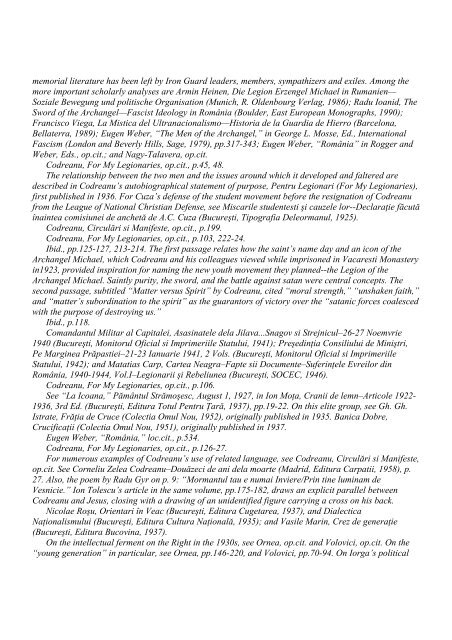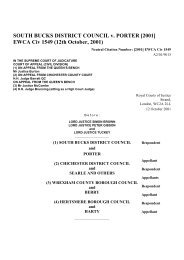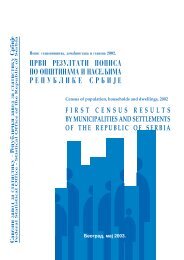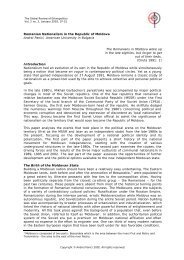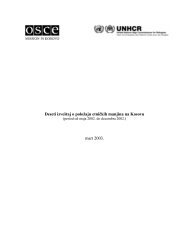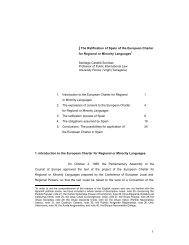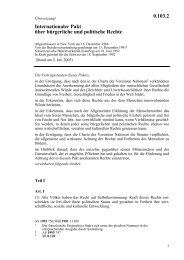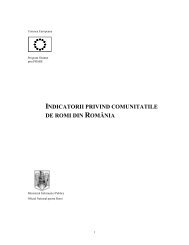Final Report of the International Commission on the - Minority Rights ...
Final Report of the International Commission on the - Minority Rights ...
Final Report of the International Commission on the - Minority Rights ...
You also want an ePaper? Increase the reach of your titles
YUMPU automatically turns print PDFs into web optimized ePapers that Google loves.
memorial literature has been left by Ir<strong>on</strong> Guard leaders, members, sympathizers and exiles. Am<strong>on</strong>g <str<strong>on</strong>g>the</str<strong>on</strong>g><br />
more important scholarly analyses are Armin Heinen, Die Legi<strong>on</strong> Erzengel Michael in Rumanien—<br />
Soziale Bewegung und politische Organisati<strong>on</strong> (Munich, R. Oldenbourg Verlag, 1986); Radu Ioanid, The<br />
Sword <str<strong>on</strong>g>of</str<strong>on</strong>g> <str<strong>on</strong>g>the</str<strong>on</strong>g> Archangel—Fascist Ideology in România (Boulder, East European M<strong>on</strong>ographs, 1990);<br />
Francisco Viega, La Mistica del Ultranaci<strong>on</strong>alismo—Historia de la Guardia de Hierro (Barcel<strong>on</strong>a,<br />
Bellaterra, 1989); Eugen Weber, “The Men <str<strong>on</strong>g>of</str<strong>on</strong>g> <str<strong>on</strong>g>the</str<strong>on</strong>g> Archangel,” in George L. Mosse, Ed., <str<strong>on</strong>g>Internati<strong>on</strong>al</str<strong>on</strong>g><br />
Fascism (L<strong>on</strong>d<strong>on</strong> and Beverly Hills, Sage, 1979), pp.317-343; Eugen Weber, “România” in Rogger and<br />
Weber, Eds., op.cit.; and Nagy-Talavera, op.cit.<br />
Codreanu, For My Legi<strong>on</strong>aries, op.cit., p.45, 48.<br />
The relati<strong>on</strong>ship between <str<strong>on</strong>g>the</str<strong>on</strong>g> two men and <str<strong>on</strong>g>the</str<strong>on</strong>g> issues around which it developed and faltered are<br />
described in Codreanu’s autobiographical statement <str<strong>on</strong>g>of</str<strong>on</strong>g> purpose, Pentru Legi<strong>on</strong>ari (For My Legi<strong>on</strong>aries),<br />
first published in 1936. For Cuza’s defense <str<strong>on</strong>g>of</str<strong>on</strong>g> <str<strong>on</strong>g>the</str<strong>on</strong>g> student movement before <str<strong>on</strong>g>the</str<strong>on</strong>g> resignati<strong>on</strong> <str<strong>on</strong>g>of</str<strong>on</strong>g> Codreanu<br />
from <str<strong>on</strong>g>the</str<strong>on</strong>g> League <str<strong>on</strong>g>of</str<strong>on</strong>g> Nati<strong>on</strong>al Christian Defense, see Miscarile studentesti şi cauzele lor--Declaraţie făcută<br />
înaintea comisiunei de anchetă de A.C. Cuza (Bucureşti, Tipografia Deleormanul, 1925).<br />
Codreanu, Circulări si Manifeste, op.cit., p.199.<br />
Codreanu, For My Legi<strong>on</strong>aries, op.cit., p.103, 222-24.<br />
Ibid., pp.125-127, 213-214. The first passage relates how <str<strong>on</strong>g>the</str<strong>on</strong>g> saint’s name day and an ic<strong>on</strong> <str<strong>on</strong>g>of</str<strong>on</strong>g> <str<strong>on</strong>g>the</str<strong>on</strong>g><br />
Archangel Michael, which Codreanu and his colleagues viewed while impris<strong>on</strong>ed in Vacaresti M<strong>on</strong>astery<br />
in1923, provided inspirati<strong>on</strong> for naming <str<strong>on</strong>g>the</str<strong>on</strong>g> new youth movement <str<strong>on</strong>g>the</str<strong>on</strong>g>y planned--<str<strong>on</strong>g>the</str<strong>on</strong>g> Legi<strong>on</strong> <str<strong>on</strong>g>of</str<strong>on</strong>g> <str<strong>on</strong>g>the</str<strong>on</strong>g><br />
Archangel Michael. Saintly purity, <str<strong>on</strong>g>the</str<strong>on</strong>g> sword, and <str<strong>on</strong>g>the</str<strong>on</strong>g> battle against satan were central c<strong>on</strong>cepts. The<br />
sec<strong>on</strong>d passage, subtitled “Matter versus Spirit” by Codreanu, cited “moral strength,” “unshaken faith,”<br />
and “matter’s subordinati<strong>on</strong> to <str<strong>on</strong>g>the</str<strong>on</strong>g> spirit” as <str<strong>on</strong>g>the</str<strong>on</strong>g> guarantors <str<strong>on</strong>g>of</str<strong>on</strong>g> victory over <str<strong>on</strong>g>the</str<strong>on</strong>g> “satanic forces coalesced<br />
with <str<strong>on</strong>g>the</str<strong>on</strong>g> purpose <str<strong>on</strong>g>of</str<strong>on</strong>g> destroying us.”<br />
Ibid., p.118.<br />
Comandantul Militar al Capitalei, Asasinatele dela Jilava...Snagov si Strejnicul–26-27 Noemvrie<br />
1940 (Bucureşti, M<strong>on</strong>itorul Oficial si Imprimeriile Statului, 1941); Preşedinţia C<strong>on</strong>siliului de Miniştri,<br />
Pe Marginea Prăpastiei–21-23 Ianuarie 1941, 2 Vols. (Bucureşti, M<strong>on</strong>itorul Oficial si Imprimeriile<br />
Statului, 1942); and Matatias Carp, Cartea Neagra–Fapte sii Documente–Suferinţele Evreilor din<br />
România, 1940-1944, Vol.I–Legi<strong>on</strong>arii şi Rebeliunea (Bucureşti, SOCEC, 1946).<br />
Codreanu, For My Legi<strong>on</strong>aries, op.cit., p.106.<br />
See “La Icoana,” Pământul Strămoşesc, August 1, 1927, in I<strong>on</strong> Moţa, Cranii de lemn–Articole 1922-<br />
1936, 3rd Ed. (Bucureşti, Editura Totul Pentru Ţară, 1937), pp.19-22. On this elite group, see Gh. Gh.<br />
Istrate, Frăţia de Cruce (Colectia Omul Nou, 1952), originally published in 1935. Banica Dobre,<br />
Crucificaţii (Colectia Omul Nou, 1951), originally published in 1937.<br />
Eugen Weber, “România,” loc.cit., p.534.<br />
Codreanu, For My Legi<strong>on</strong>aries, op.cit., p.126-27.<br />
For numerous examples <str<strong>on</strong>g>of</str<strong>on</strong>g> Codreanu’s use <str<strong>on</strong>g>of</str<strong>on</strong>g> related language, see Codreanu, Circulări si Manifeste,<br />
op.cit. See Corneliu Zelea Codreanu–Douăzeci de ani dela moarte (Madrid, Editura Carpatii, 1958), p.<br />
27. Also, <str<strong>on</strong>g>the</str<strong>on</strong>g> poem by Radu Gyr <strong>on</strong> p. 9: “Mormantul tau e numai Inviere/Prin tine luminam de<br />
Vesnicie.” I<strong>on</strong> Tolescu’s article in <str<strong>on</strong>g>the</str<strong>on</strong>g> same volume, pp.175-182, draws an explicit parallel between<br />
Codreanu and Jesus, closing with a drawing <str<strong>on</strong>g>of</str<strong>on</strong>g> an unidentified figure carrying a cross <strong>on</strong> his back.<br />
Nicolae Roşu, Orientari în Veac (Bucureşti, Editura Cugetarea, 1937), and Dialectica<br />
Naţi<strong>on</strong>alismului (Bucureşti, Editura Cultura Naţi<strong>on</strong>ală, 1935); and Vasile Marin, Crez de generaţie<br />
(Bucureşti, Editura Bucovina, 1937).<br />
On <str<strong>on</strong>g>the</str<strong>on</strong>g> intellectual ferment <strong>on</strong> <str<strong>on</strong>g>the</str<strong>on</strong>g> Right in <str<strong>on</strong>g>the</str<strong>on</strong>g> 1930s, see Ornea, op.cit. and Volovici, op.cit. On <str<strong>on</strong>g>the</str<strong>on</strong>g><br />
“young generati<strong>on</strong>” in particular, see Ornea, pp.146-220, and Volovici, pp.70-94. On Iorga’s political


